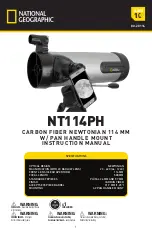
5
and to learn the official names of all the interesting lunar landscape features you
see with the FunScope.
3. Getting started
Setup
Your FunScope arrives assembled from the
factory; you just need to install the visual
accessories. These will be found in a box
within the main box.
1. Attach the red dot finder scope (6) to
the optical tube (1) by inserting the
finder scope’s bracket into the finder
scope base (7), as shown in Figure
3, until it clicks. (To remove the finder
scope, press the small tab at the back
of the base and slide the bracket out.)
2. Now you will insert an eyepiece (5) into
the focuser. We recommend starting
with the 20mm eyepiece, which pro-
vides lower power and a wider field of
view than the 6mm eyepiece. Loosen
the eyepiece securing thumbscrew
(4), then insert the chrome barrel of
the 20mm eyepiece into the focuser
(2) and secure it with the thumbscrew.
It’s best to get a feel for the basic functions of the FunScope during the day,
before observing astronomical objects at night. This way you won’t have to
orient yourself in the dark! Find a spot outdoors where you’ll have plenty of
room to move the telescope, and where you’ll have a clear view of some
object or vista that is at least 1/4 mile away. It is not critical that the telescope
be exactly level, but it should be placed on a relatively flat surface to ensure
smooth movement.
The FunScope was designed specifically for visual observation of astro-
nomical objects in the night sky. Like all Newtonian reflector telescopes, it is
not suited for daytime terrestrial usage because the image in the eyepiece is
rotated (upside-down).
One of the great assets of the FunScope is its extremely portable size. Due
to its overall short height, you will find that viewing while sitting next to the
telescope is the most comfortable. If you wish to raise the telescope off the
ground so that it can be used while standing or sitting in a chair, then a plat-
form such as a milk crate or table can be used.
Figure 3.
Attaching the red dot
scope to the telescope.
Finder scope
base






































